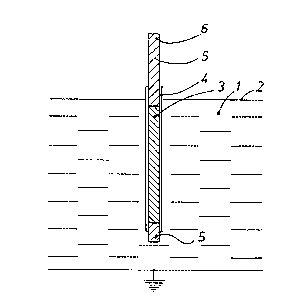Une partie des informations de ce site Web a été fournie par des sources externes. Le gouvernement du Canada n'assume aucune responsabilité concernant la précision, l'actualité ou la fiabilité des informations fournies par les sources externes. Les utilisateurs qui désirent employer cette information devraient consulter directement la source des informations. Le contenu fourni par les sources externes n'est pas assujetti aux exigences sur les langues officielles, la protection des renseignements personnels et l'accessibilité.
L'apparition de différences dans le texte et l'image des Revendications et de l'Abrégé dépend du moment auquel le document est publié. Les textes des Revendications et de l'Abrégé sont affichés :
| (12) Brevet: | (11) CA 1274874 |
|---|---|
| (21) Numéro de la demande: | 1274874 |
| (54) Titre français: | METHODE POUR COMMUNIQUER DE L'ENERGIE THERMIQUE A UN METAL EN FUSION, ET DISPOSITIF CHAUFFANT POUR LA MISE EN OEUVRE DE LADITE METHODE |
| (54) Titre anglais: | METHOD OF SUPPLYING HEAT ENERGY TO A METAL MELT OR THE LIKE AND A HEATING ELEMENT FOR USE WITH SAID METHOD |
| Statut: | Périmé et au-delà du délai pour l’annulation |
| (51) Classification internationale des brevets (CIB): |
|
|---|---|
| (72) Inventeurs : |
|
| (73) Titulaires : |
|
| (71) Demandeurs : |
|
| (74) Agent: | SMART & BIGGAR LP |
| (74) Co-agent: | |
| (45) Délivré: | 1990-10-02 |
| (22) Date de dépôt: | 1986-02-06 |
| Licence disponible: | S.O. |
| Cédé au domaine public: | S.O. |
| (25) Langue des documents déposés: | Anglais |
| Traité de coopération en matière de brevets (PCT): | Non |
|---|
| (30) Données de priorité de la demande: | |||||||||
|---|---|---|---|---|---|---|---|---|---|
|
ABSTRACT
The invention relates to a method and apparatus for
supplying heat energy to a metal weld or similar electroconductive
fluid. According to the method, a rod-like element or elements
are partly immersed in the metal melt or electroconductive fluid.
An end portion of each element is connected to electric power.
The end portion of each element and another end portion disposed
at the opposite end of each element consist of an electrocon-
ductive material, while a relatively long center portion of each
element consists of an electrically resistant material. A segment
of each element which is contiguous with at least the portion of
each element which is comprised of electrically resistant
material, is coated with an electrically insulated heat conductive
coat which allows heat transfer from the electrically resistant
portion of each element to the melt. The heating elements for the
implementation of the method are disposed so that the end portions
project from the melt to allow connection to an electric power
source. The end portion of each element consists of a material
that is a good electric conductor, and the longer center portion
is composed of an electrically resistant material. The coating
consists of a material made from one or more oxides of metal or
metalloids.
Note : Les revendications sont présentées dans la langue officielle dans laquelle elles ont été soumises.
Note : Les descriptions sont présentées dans la langue officielle dans laquelle elles ont été soumises.

2024-08-01 : Dans le cadre de la transition vers les Brevets de nouvelle génération (BNG), la base de données sur les brevets canadiens (BDBC) contient désormais un Historique d'événement plus détaillé, qui reproduit le Journal des événements de notre nouvelle solution interne.
Veuillez noter que les événements débutant par « Inactive : » se réfèrent à des événements qui ne sont plus utilisés dans notre nouvelle solution interne.
Pour une meilleure compréhension de l'état de la demande ou brevet qui figure sur cette page, la rubrique Mise en garde , et les descriptions de Brevet , Historique d'événement , Taxes périodiques et Historique des paiements devraient être consultées.
| Description | Date |
|---|---|
| Inactive : CIB de MCD | 2006-03-11 |
| Inactive : CIB de MCD | 2006-03-11 |
| Le délai pour l'annulation est expiré | 2004-10-04 |
| Lettre envoyée | 2003-10-02 |
| Inactive : TME en retard traitée | 1997-10-24 |
| Lettre envoyée | 1997-10-02 |
| Accordé par délivrance | 1990-10-02 |
Il n'y a pas d'historique d'abandonnement
| Type de taxes | Anniversaire | Échéance | Date payée |
|---|---|---|---|
| TM (catégorie 1, 7e anniv.) - petite | 1997-10-02 | 1997-10-24 | |
| Annulation de la péremption réputée | 2002-10-02 | 1997-10-24 | |
| TM (catégorie 1, 8e anniv.) - petite | 1998-10-02 | 1998-10-02 | |
| Annulation de la péremption réputée | 2002-10-02 | 1998-10-02 | |
| Annulation de la péremption réputée | 2002-10-02 | 1999-09-20 | |
| TM (catégorie 1, 9e anniv.) - petite | 1999-10-04 | 1999-09-20 | |
| Annulation de la péremption réputée | 2002-10-02 | 2000-09-25 | |
| TM (catégorie 1, 10e anniv.) - petite | 2000-10-02 | 2000-09-25 | |
| TM (catégorie 1, 11e anniv.) - petite | 2001-10-02 | 2001-09-07 | |
| Annulation de la péremption réputée | 2002-10-02 | 2001-09-07 | |
| Annulation de la péremption réputée | 2002-10-02 | 2002-09-23 | |
| TM (catégorie 1, 12e anniv.) - petite | 2002-10-02 | 2002-09-23 |
Les titulaires actuels et antérieures au dossier sont affichés en ordre alphabétique.
| Titulaires actuels au dossier |
|---|
| SCANTHERM A/S |
| Titulaires antérieures au dossier |
|---|
| CATO EVENSEN |